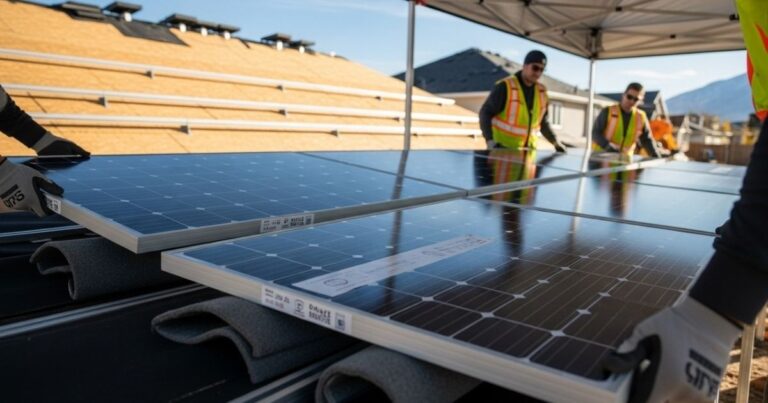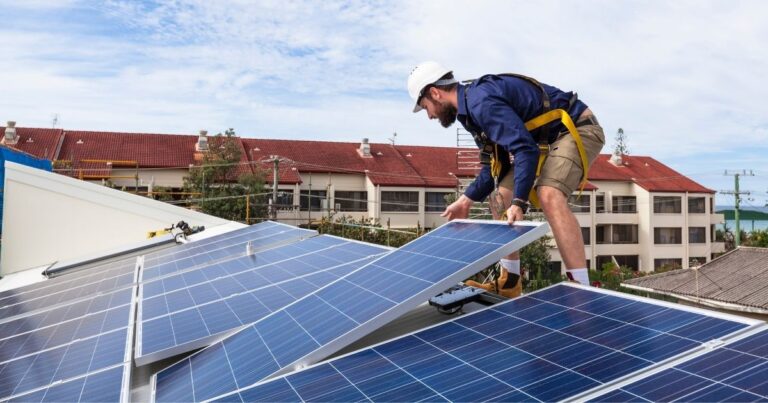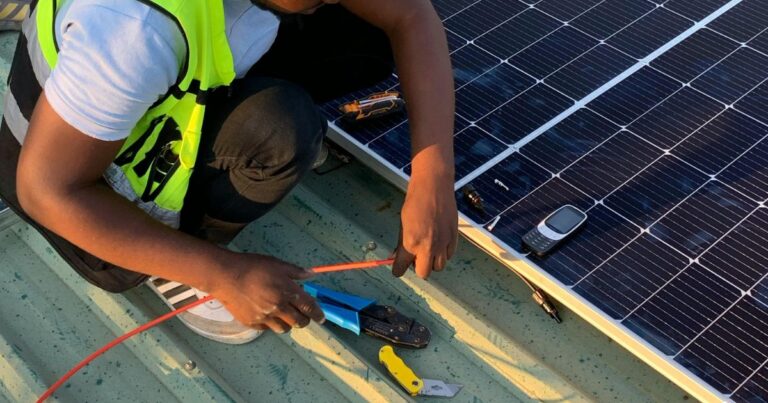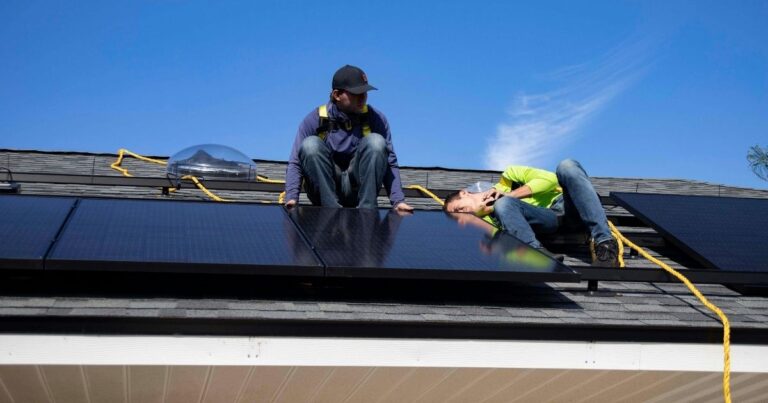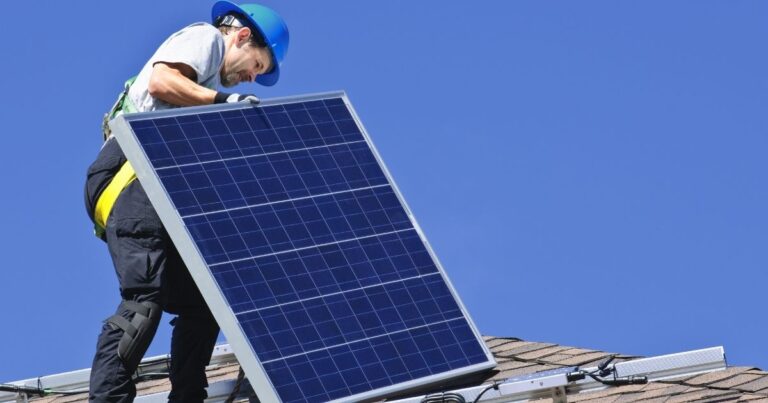How to Protect Your Solar Warranty During Roof Work
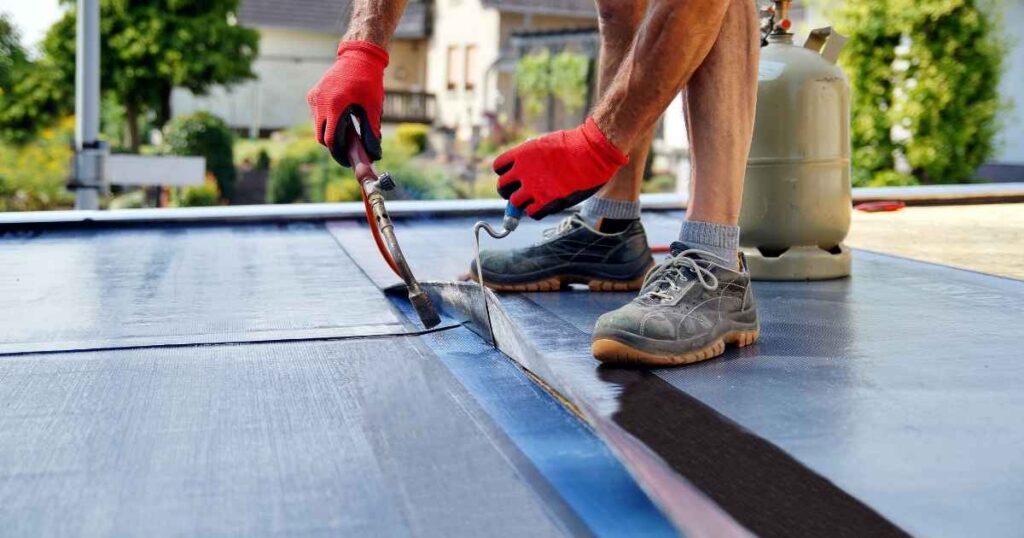
Replacing or repairing a roof when solar panels are involved can feel overwhelming. Many homeowners worry: will this roof project void my solar warranty? Roofing contractors and insurance adjusters face similar challenges, often unsure how to handle solar systems without causing delays, liability, or costly mistakes. This guide will show you exactly how to protect your solar panel warranty during roof replacement by explaining the risks, outlining safe practices, and walking through warranty-safe detach and reset solutions.
Here’s what we’ll cover:
- Why Roof Work Can Put Your Solar Warranty at Risk
- What Happens to Solar Panels During Roof Replacement
- The Professional Detach & Reset Process Explained
- How to Protect Your Warranty in Different Scenarios
- Cost Considerations for Solar Detach & Reset in Utah
- Why Roofing Contractors and Insurance Professionals Need a Solar Partner
- Choosing a Warranty-Safe Solar Removal Specialist in Northern Utah
First, let’s look at why roof work—even when necessary—can put your solar warranty at risk if it’s not handled correctly.
Why Roof Work Can Put Your Solar Warranty at Risk
When it’s time to repair or replace your roof, your solar panels can’t just stay in place. They need to be carefully removed and reinstalled—a process that, if mishandled, could put your solar panel warranty at risk. Many homeowners are surprised to learn that a warranty can be voided simply because the panels weren’t detached using manufacturer-approved solar removal methods—highlighting the importance of knowing who can remove solar panels during roof work safely and correctly.
Here’s why this matters:
- Voided Warranties: Most solar manufacturers specify that only qualified professionals can disconnect and reinstall panels. If an untrained roofer or handyman attempts it, your warranty protections may no longer apply. That means future repairs or replacements on your solar equipment could come entirely out of your pocket.
- Panel Damage: Solar panels are delicate electrical systems, and incorrect handling can cause cracks, bent frames, or electrical failures. Even a small oversight can compromise system performance.
- Lost Energy Production: If panels aren’t reinstalled and tested correctly, you may see reduced efficiency and energy output. A warranty might cover defective equipment, but it won’t cover poor workmanship during a roof project.
- Insurance Complications: If storm damage triggers both roof repairs and solar handling, insurance companies expect clear documentation that panels were removed and reinstalled properly. Without this, claims can be delayed or denied.
- Think of it this way: your solar warranty is like a safety net for your investment. But that net only holds if you follow the rules set by the manufacturer. Roof work—whether planned or caused by storm damage—puts that net at risk unless the right professionals are involved.
Key takeaway: Roof replacements and storm repairs don’t have to endanger your solar system. By working with trained specialists who follow manufacturer-approved methods, you can protect your solar panel warranty during roof replacement and avoid costly mistakes down the road.
What Happens to Solar Panels During Roof Replacement
If your home has solar panels and it’s time for a new roof, the panels can’t simply stay put. To access the shingles or underlayment, they must be detached, stored safely, and reinstalled once the roof work is complete. This step is unavoidable, but it often raises big questions for homeowners, roofers, and even insurance adjusters.
So, who removes solar panels when replacing a roof? In most cases, it’s not your roofer. Roofing contractors are experts in shingles, flashing, and ventilation—not in disconnecting live electrical systems. Most roofing crews are not licensed or trained to touch solar equipment, and if they do, they risk damaging the panels, creating safety hazards, or voiding your warranty. That’s why many roofers will tell homeowners, “We can replace your roof, but you’ll need someone else to handle the solar.”
You might wonder, “Why can’t my roofer just handle the solar panels?” The short answer: liability. Solar systems involve electrical wiring, manufacturer-specific hardware, and warranty requirements. If a roofer accidentally damages your inverter or miswires a panel during reinstallation, the consequences could be expensive. Worse, the manufacturer may refuse to honor the warranty because the work wasn’t done by a qualified professional.
Some homeowners consider DIY removal, thinking it’s just a matter of unscrewing panels. But the reality is much riskier. Panels are heavy and fragile, electrical components must be properly de-energized, and the system has to be documented before removal—see our guide on how to remove solar panels safely for details. A single mistake could lead to cracked glass, water leaks, or a solar system that never performs the same again.
Key takeaway: During a roof replacement, removing solar panels for roof replacement is essential—but only a trained solar detach and reset team can do this safely. Roofing contractors handle the roof, while solar specialists ensure your system is removed, stored, and reinstalled without risking your investment or your warranty.
The Professional Detach & Reset Process Explained
When your roof needs work, the safest way to handle your solar panels is through a professional detach and reset service. This process ensures your warranty stays intact, your system is protected, and your roof replacement can move forward without delays. Here’s what it looks like in practice:
Step 1: System Documentation
Before anything is removed, the solar team documents the system in detail, then performs professional detach service using manufacturer‑approved methods. This full-system solar documentation is especially important for insurance claims and ensures every panel goes back exactly where it belongs.
Step 2: Safe Removal and Secure Storage
Each panel is carefully disconnected using manufacturer‑approved methods, then moved to secure panel storage—either on‑site or off‑site depending on space and safety. Proper handling prevents cracked glass, bent frames, or damaged connectors, while storage keeps panels protected from weather and jobsite activity.
Step 3: Roof Replacement Completion
With the panels safely out of the way, your roofing contractor can complete the replacement or repair without obstruction. This step keeps the workflow efficient—roofers do what they do best, while the solar system is protected until it’s ready to return.
Step 4: Reinstallation, Inspection, and System Check
Once the new roof is ready, the solar team reinstalls every component, reconnects the wiring, and runs a final inspection following the how to remove and reinstall solar panels for roof work protocol. This inspection verifies that your system is producing power correctly and that everything meets manufacturer standards for continued warranty coverage.
The entire process is designed to be fast, safe, and warranty-compliant. By keeping responsibilities clear—roofers focus on the roof, solar specialists handle the panels and perform professional panel reinstallation—you avoid unnecessary risk, delays, or costly mistakes.
Key takeaway: A professional detach and reset isn’t just about moving panels. It’s about protecting your solar investment, keeping your roof project on track, and ensuring your warranty remains valid long after the work is done.
How to Protect Your Warranty in Different Scenarios
Not every roofing project looks the same. Sometimes a storm forces sudden repairs, while other times it’s a planned roof replacement after years of wear and tear. In each case, the way your solar panels are handled can make or break your warranty coverage. Here’s how to keep your warranty protected in common situations:
Storm or Hail Damage Repairs
Severe storms can damage both roofs and solar systems. When this happens, insurance companies expect clear documentation of the removal and reinstallation process. A professional detach and reset team provides insurance claim solar panel documentation—including photos, serial numbers, and condition reports—so adjusters can accurately assess the damage. This protects you from disputes, keeps the claim moving, and ensures your panels are reinstalled correctly after storm damage roof repair with solar panels.
Standard Roof Replacements
When a roof reaches the end of its life or you’re upgrading materials, solar panels must come off before the work begins. The challenge is making sure this doesn’t jeopardize your warranty. Using manufacturer‑approved methods is the only way to keep your solar panel warranty valid after reroofing—and working with certified detach & reset firms ensures those methods are followed precisely.
With proper detach & reset services, the process is seamless: your roof gets replaced, your panels are protected, and your warranty remains intact.
Insurance Claims & Adjuster Projects
For adjusters and restoration teams, documentation is everything. They need proof that panels were safely removed, securely stored, and reinstalled without cutting corners. A qualified solar partner ensures insurance adjuster solar project coordination, delivering detailed records and verification of the system’s performance after reinstallation. This provides claim accuracy and solar reinstallation proof, helping adjusters close claims efficiently and keeping homeowners confident their warranty is still in force.
Key takeaway: Whether it’s storm damage, routine reroofing, or an insurance-driven project, protecting your warranty comes down to one thing—working with trained solar professionals who document, detach, and reinstall panels the right way.
Cost Considerations for Solar Detach & Reset in Utah
One of the first questions homeowners ask is, “How much does it cost to remove and reinstall solar panels for a roof replacement?” The answer depends on several factors, which is why there isn’t a one-size-fits-all price tag. Instead, it’s more helpful to understand what drives the cost of a solar detach and reset in Utah.
System Size and Complexity
The number of panels on your roof directly affects cost. A home with 10 panels will be quicker and less labor-intensive than a home with 40. Unique layouts—such as panels installed on multiple roof sections—also require more time and coordination.
Roof Accessibility and Design
Steeper roofs, multi-story homes, or roofs with limited access may require additional safety equipment and handling time. The more complex the roof, the more careful planning and labor are needed.
Storage Needs
Panels must be kept safe while the roof is being replaced. For more on this, read about storing panels safely during roof work to understand your options. This choice can affect the overall cost.
Condition After Storm Damage
If the project is related to hail or wind damage, some panels may need inspection, testing, or even replacement. In those cases, costs can vary depending on the extent of the storm damage and the solar panel reinstallation requirements after storm damage.
Insurance Coverage
When roof work is tied to an insurance claim, some or all of the detach and reset cost may be covered. Having clear documentation from a professional solar team helps ensure adjusters can approve the work.
While the solar panel detach and reset cost in Utah varies, what doesn’t change is the importance of having the work done by a qualified specialist. This ensures your panels are protected, your system is reinstalled to manufacturer standards, and your warranty stays intact.
Key takeaway: Cost depends on your system and situation, but cutting corners with unqualified removal can end up far more expensive. A professional detach and reset service protects both your investment and your peace of mind.
Why Roofing Contractors and Insurance Professionals Need a Solar Partner
For roofing contractors and insurance professionals, solar panels often represent an unexpected hurdle. They can delay projects, create liability risks, and complicate communication with homeowners. Partnering with a dedicated solar detach and reset team removes that burden—keeping jobs on schedule, protecting warranties, and ensuring everyone involved has peace of mind.
Professional solar support services provide:
- Liability-free solar removal for roofers
- Accurate documentation for insurance adjusters
- Seamless project coordination between trades
For Roofing Contractors
When a roof replacement involves solar, many contractors hesitate to touch the panels—and for good reason. Mishandling them can void warranties, create costly damage, and shift liability onto the roofer. By relying on solar subcontractor support, roofers can:
- Hand off solar responsibilities to specialists trained in manufacturer-approved methods.
- Keep projects moving without waiting weeks for a solar installer to respond.
- Focus entirely on roofing while knowing the panels will be safely removed, stored, and reinstalled.
The result? Faster job completion, fewer risks, and happier homeowners.
For Insurance Adjusters
Storm or hail claims involving solar panels require precision. Adjusters need accurate, timely documentation to validate claims and keep the process moving. A trusted solar partner provides:
- Complete system documentation before removal.
- Verified reinstallation records for claim accuracy and solar reinstallation proof.
- Direct communication to eliminate delays and prevent missteps.
With this support, adjusters can close claims faster, reduce disputes, and maintain homeowner satisfaction.
Key takeaway: Roofing contractors and insurance professionals don’t need to carry the burden of solar complications. A dedicated solar partner eliminates risks, streamlines workflows, and ensures every project is completed smoothly and warranty-safe.
Choosing a Warranty-Safe Solar Removal Specialist in Northern Utah
When it comes to protecting your solar investment during roof work, not every contractor is the right fit. You need a team that specializes in solar—not a generalist trying to “figure it out” on the job. In Northern Utah, that means working with a provider who is experienced, insured, and trained to follow manufacturer-approved methods every step of the way.
A certified solar panel removal and reinstallation team in Northern Utah brings more than technical skill—they bring peace of mind. Here’s what to look for:
- Specialization in Solar Detach & Reset: Unlike roofing companies or electrical contractors that dabble in solar, a specialist focuses solely on removing, storing, and reinstalling panels. This expertise ensures the process is smooth, efficient, and warranty-safe.
- Insured and Professional: Handling high-value equipment comes with risks. Choosing a fully insured team protects both homeowners and contractors from unexpected costs if damage occurs.
- Manufacturer-Approved Practices: Every panel is removed, stored, and reinstalled according to the standards required to keep warranties valid. No guesswork, no shortcuts—just proven methods.
- Local Expertise: A Northern Utah-based team understands the challenges of the region—from frequent hailstorms to varied roof types. Local experience means faster response times and a partner who knows how to work within insurance and contractor timelines in your area.
Key takeaway: The safest way to protect your solar panel warranty during roof replacement is to choose a trusted, local specialist. In Northern Utah, that means working with a team that does one thing—and does it right: warranty-safe solar detach and reset.
Conclusion – Peace of Mind for Roof Work with Solar Panels
Replacing or repairing a roof when solar panels are involved doesn’t have to be stressful. The key is making sure your panels are removed and reinstalled the right way—using manufacturer-approved methods that keep your warranty intact and avoid problems like does removing solar panels damage the roof. With professional detach and reset services, you can avoid risks like damaged panels, voided warranties, and insurance claim delays.
For homeowners, this means protecting your solar investment and reducing the stress of roof work. For roofing contractors, it means eliminating liability and keeping projects on schedule. And for insurance adjusters, it ensures accurate documentation, smooth claims, and satisfied policyholders.
When you choose a local, warranty-safe specialist, you gain more than technical support—you gain a trusted solar partner who keeps every project moving forward without compromise.
Frequently Asked Questions
Not if it’s handled correctly. Most solar manufacturers require panels to be removed and reinstalled by qualified professionals using approved methods. If a roofer or untrained worker disconnects the system, your warranty may be voided. Hiring a specialist ensures your warranty remains valid during roof replacement.
Roofing contractors usually do not handle solar panels, since they aren’t licensed or trained to work with electrical systems. A dedicated solar detach and reset team safely removes, stores, and reinstalls the panels once the roof work is complete.
Costs vary depending on system size, roof complexity, storage needs, and whether storm damage is involved. In Utah, insurance may cover some or all of the expense when the project is claim-related. A professional can provide an estimate based on your specific situation.
In cases of hail or wind damage, panels are carefully documented, detached, and stored while the roof is repaired—and then undergo warranty‑compliant repairs before reinstallation. Insurance adjusters often require detailed records of the process. After the roof is fixed, panels are reinstalled and tested to ensure proper performance.
The best way is to bring in a solar partner early. A dedicated detach and reset team coordinates directly with your roofer and, if needed, your insurance adjuster. This prevents scheduling conflicts, reduces downtime, and ensures your project stays on track.

